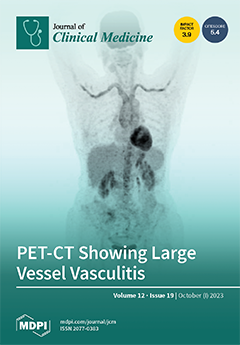In recent decades, infusion solutions such as NaCl 0.9% and lactate Ringer’s solution have been replaced in clinical practice. Since 2017, the national guidelines for perioperative infusion therapy in children recommend balanced isotonic solutions to maintain fluid balance. The composition of balanced infusion solutions varies with respect to their electrolyte content. Hyperchloremia may be mistaken for hypovolemia and may interfere with volume therapy in pediatric patients. Sterofundin ISO
® balanced solution contains 127 mmol/L chloride and may cause hyperchloremic acidosis if administered in large volumes. Objectives: The purpose of this study was to compare the effects of Sterofundin ISO
® (SF) therapy with the balanced isochloremic solution Deltajonin
® (DJ) (106 mmol/L chloride) on the acid–base status in infants undergoing craniofacial surgery. Methods: This retrospective, non-blinded study included 100 infants undergoing craniectomy due to isolated nonsyndromic sagittal craniosynostosis. The first 50 infants received Sterofundin ISO
®. Due to changes in national guidelines, the infusion was changed to the isoionic Deltajonin
® in an additional 50 infants in 2017. Pre- and postoperative values of chloride, pH, base excess, bicarbonate, and albumin and phosphate were determined, and the strong-ion difference, strong-ion gap, anion gap, and weak acids were calculated. Results: Both groups were comparable in terms of their age, sex, underlying disease, preoperative electrolytes (except K at 3.9 ± 0.3 mmol/L (SF) vs. 4.1 ± 0.3 mmol/L (DJ) and lactate 8.7 ± 2.1 (SF) vs. 9.6 ± 2.6 mmol/L (DJ)). In the Sterofundin ISO
® group, hyperchloremic metabolic acidosis was observed in 19 patients, whereas only 2 infants in the Deltajonin
® group had hyperchloremic metabolic acidosis. The postoperative chloride level was 111 ± 2.7 mmol/L (SF) vs. 108 ± 2.4 mmol/L (DJ). The difference in anion gap was 12.5 ± 3.0 mmol/L (SF) vs. 14.6 ± 2.8 mmol/L (DJ), and the difference in SIDa (apparent strong-ion difference) was 30.9 mmol/L (SF) vs. 33.8 mmol/L (DJ). Conclusions: Hyperchloremic acidosis can be induced by the volume replacement with high-chloride-concentration crystalloids such as Sterofundin ISO
®. This can be detected using the Stewart model.
Full article






